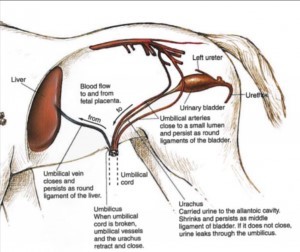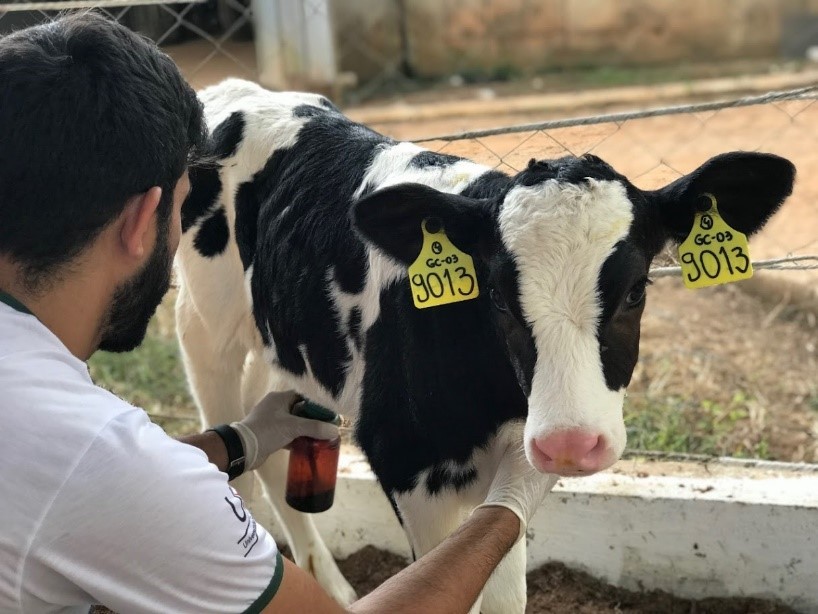Dairy Farming Essentials: Navel Care Beyond the Dip
Camila Lage, Dairy Management Specialist
Southwest New York Dairy, Livestock and Field Crops Program
Disinfecting the navel cord is a common practice among farms and, for the most part, a pretty straightforward process. However, recent studies have shown that there is more to navel care than we realize. According to a study from Cornell University published in the Journal of Dairy Science (Wieland et al., 2017), umbilical infections may be more common than we diagnose on farms. While older studies indicate that just 1.3% to 14% of calves develop an umbilical infection, these authors, using more advanced technology, diagnosed umbilical disorders in 27% of all calves enrolled in their study. More studies are being conducted to learn more about the implications this might have on calves and what else we can do to improve the diagnosis, reduce the incidence, and improve the treatment of umbilical infections. In the meantime, this article aims to review what we already know and how to fine-tune our management to guarantee an effective procedure for navel care.
What is the navel cord?
The navel or umbilical cord is the connection between the placenta of the dam and the fetus, passing through the calf's abdomen at the navel. It transports nutrients and oxygen to the fetus and carries waste products from the fetus to the dam to be excreted. The cord includes two arteries, a vein, and the urachus (channel between the bladder and the umbilicus) (Figure 1). At birth, the umbilical cord ruptures, and in a normal process, the structures retract into the abdomen, leaving the umbilical cord extending through the navel by 2 to 6 inches. If the cord doesn't get infected, it will dry up and shrink in the next 7 to 10 days.
Since the internal structures of the cord serve no purpose once the calf is born, they will also atrophy. However, before the cord is completely dried out, disease-causing pathogens from the environment can be wicked up the cord. In less severe cases, this causes an infection localized to the navel, but in more severe cases, the infection can travel further into the abdomen causing anything from liver infection to joint, respiratory, or systemic infections and death.

Figure 1. Diagram of internal nutrient and waste management structures attached to the umbilical cord in a young mammal. https://open.lib.umn.edu/largeanimalsurgery/chapter/umbilical-infections-and-patent-urachus/
Why is navel cord care critical?
In a perfect world, all calves would have no problems with the umbilical cord shrinking after birth. The reality is that this doesn't happen 100% of the time. In some cases, the cord does not retract normally as a result of an excessively long or short external umbilical cord (due to genetics or traumatic events during calving) or a urachus that remains open and dribbling urine, which facilitates infection. We also see navels that do not close completely due to a navel hernia, which is usually linked to genetics as well.
In the study mentioned previously, (Wieland et al., 2017) the authors concluded that risk factors for navel infections include: calves born from cows that have given birth before, calves that are heavier at birth, and calves with a short umbilical cord at birth. They also found that calves developed an umbilical infection in over 50% of cases where the umbilical cord was short (ruptured at the attachment to the body wall). Calves with any of these conditions are more prone to infections, which means they need extra attention and care. Currently, no protocols for decreasing the number of calves with ruptured cords are available. One of the reasons for this is that we have low diagnosis and documentation of navel issues, limiting the development of solutions for the various problems we can encounter on our farms.
We have come a long way on calf care, but moving forward, we still have a lot to figure out. As with most of the tasks on the farm, we need to do the basics very well, naval care included. In the section below, we will go over the most critical steps to prevent infections and the best practices when using a dip to disinfect the cord:
Preventing infections
- Keeping it clean: Clean and dry calving areas are the first step toward success in the navel care program since they will reduce the exposure of the "fresh" umbilical cord to bacteria. This is also true for the facility the calf is being taken to next. Calf bedding should be clean, dry, and abundant!
- Minimizing the calf`s time in the maternity pen: Reducing the time the calf spends in the maternity pen after birth will likely reduce the calf's exposure to bacteria and reduce the chance of accidents, which include excessive licking or stepping on the umbilical cord.
- Dipping the navel ASAP: Disinfection of the umbilical cord is essential for three main reasons: to wash the dirt, kill bacteria and help dry up the cord (if using an alcohol-based product). The sooner you can do it the better since it will reduce the chance of colonization of the cord by bacteria. A tincture of iodine (7% or more) is the most used solution, but because of regulations on iodine sales and its reduced availability, other products are available with similar efficacies. Chlorhexidine 2% is the most used alternative and has the advantage of having high success in the presence of organic matter.
Best practices when using a dip to disinfect the cord:
- Use gloves: Navel care solutions usually have alcohol or other caustic ingredients that cause human skin irritation.
- Dip the whole navel and avoid the skin around it: Make sure you cover the entire navel cord (especially when calves have very long navels). Avoid intervention, like cutting the navel cord, if not extremely necessary. Also, avoid dipping the skin around the navel as we don't want to cause skin irritation in places that do not need to be disinfected. Extra tip: Use a non-return dip or small disposable cup to ensure you don't contaminate your solution.

Figure 2. Using a non-return cup to dip the navel (Photo: Rafael Azevedo)
- Keep the solution clean: A dirty cup can reduce the efficacy of the disinfectant and spread bacteria. If utilizing a reusable non-return cup, make sure you dispose of the extra solution and wash the part that comes into contact with the calf after each use. If you use iodine, ensure you keep your solution in an amber flask since direct light can reduce its effectiveness.
- Have impeccable colostrum management: Part of disease prevention is maximizing the ability of the animal to fight infection. For newborn calves, it means early and adequate intake of high-quality colostrum since young calves lack disease protection because antibodies do not pass across the cow's placenta to the fetus' circulatory system. (Read more about colostrum management here).
- Re-dip the navel: Although one application of the navel solution may be enough when calves are born in clean environments, some navel cords need extra help to dry without issues. Disinfecting the navel a second time within the first day of life and daily after that for two additional days may help to improve your navel care management.
- You can not manage what you don't measure: Navel infections are often not diagnosed in calves since it is hard to identify them visually. You need to palpate the navel cord to confirm. To track whether your navel care program is working, calves should be checked 2 or 3 times during the first week of age (until the cord is healed). The cord should not be any bigger than your thumb. It should also be soft and not cause discomfort when squeezed. The goal is to have less than 1% of the calves on your farm develop navel infections. A helpful tool is the Calf Health Score Charts developed by the University of Wisconsin - Madison to score the navel (see chart below). Whenever feasible, keep records to identify quickly when procedures or products are not working correctly.

- Work with your Veterinarian to create a treatment protocol for navel infections: Early identification and correct treatment can reduce the mortality of animals with navel infections.
This information is for educational and reference purposes and is not a substitute for sound veterinarian consultation and following product labels. Cornell Cooperative Extension is dedicated to providing research-based information to our agricultural producers. Every effort has been made to provide correct, complete, and up-to-date recommendations.
References:
Rings, M.D.; Anderson, D.E. CHAPTER 81—Umbilical Surgery in Calves. In Food Animal Practice, 5th ed.; Elsevier Health Sciences: Amsterdam, The Netherlands, 2009; pp. 391-397.
https://livestock.extension.wisc.edu/articles/navel-care-for-beef-x-dairy-calves/
https://www.vetmed.wisc.edu/fapm/wp-content/uploads/2020/01/CalfHealthScoringChart-2018-EN-std.pd
Upcoming Events
WNY Pastureland Conversion & Soil Health Field Day
July 16, 2025
Middleport, NY
Join American Farmland Trust for the Western New York Soil Health Field Day on July 16, 2025, at Zeliff Farm in Middleport, NY, from 9:00 AM-3:15 PM. Learn about pasture conversion, soil health benchmarking, biochar in grazing systems, and best grazing practices. Plus, enjoy hands-on demos with the NY Soil Health Trailer, drones, and cover crops! Check out the attached agenda for more information about the field day and REGISTER HERE. Zeliff Farms is a regenerative beef operation who has recently partnered with AFT on outreach and education to farmers including learning circles and evaluating biochar effects on soil health.
IPM Strategies to Protect Corn and Soybean Seed in NY
July 30, 2025
Hamburg , NY
SWNYDLFC and Cornell IPM are hosting a grower meeting to discuss integrated pest management strategies for protecting corn and soybean seed in New York.
FAMACHA Training for Sheep and Goat producers in Woodhull NY
August 13, 2025 : FAMACHA Training in Woodhull
Woodhull, NY
Join us for a discussion and hands-on training for internal parasite integrated pest management in sheep and goats. Certification is available to all students participating in the workshop.
Announcements
No announcements at this time.





